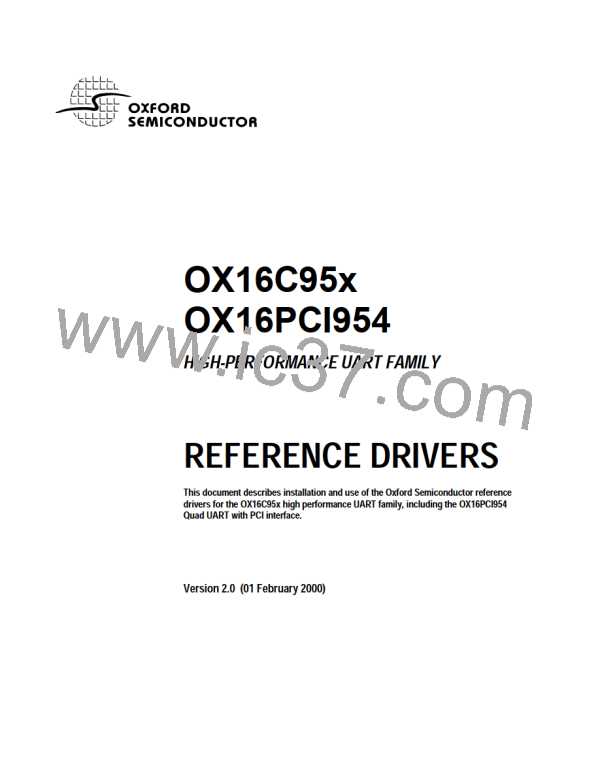Custom solutions & drivers for the OX16PCI954
VERSION 1.0
5 USING THE SERIAL DRIVER
The serial drivers for Windows 9x and Windows 2000 make use of a number of enhanced 95x UART features, and are highly configurable.
This section describes the configuration utilities, accessible through Device Manager, which can be used to enable and configure the
various features
The driver will install the correct number of serial ports and Windows will assign COM numbers to them (e.g. COM5). You can then attach
modems etc. to the ports and make use of them in the same fashion as any other generic port. The serial driver has extra configuration
options available over and above the standard ‘settings’ tab supplied with the generic 16550 driver. To adjust any of the UART parameters,
follow these steps:
1. Click on Start / Settings / Control Panel
2. Double click “System” to bring up the system properties dialog box
3. Select the “Device Manager” tab of this dialog (with the “View devices by type” option selected
4. Now click on the [+] next to the “Ports (COM & LPT)” icon to show the list of installed COM ports
5. Double click on an Oxford Semiconductor port to display the settings dialog for that port
The enhanced features are configurable through three dialog pages:
Settings
Data Rate
FIFOs
- Standard port settings found on normal COM port settings pages
- Advanced data rate selection options
- Device mode selection and FIFO trigger level settings
5.1.1 Windows 95/98 configuration
Settings
This page contains the standard Baud rate / Data bits / Parity / Stop bits and Flow control options found on most COM port settings pages.
These settings modify the default settings used by Windows. Most applications that use COM ports will override these settings with their
own comms parameters. Note that the baud rate selected by an application will be scaled up if a faster crystal is used
This page also provides configurable RS485 half-duplex operation. RS232 applications will not use this, and the DTR pin should be
configured as ‘normal’. However if RS485 line drivers are used, the driver can configure the DTR pin to enable the transmitter, in active-high
or active-low form.
Data Rate
This page provides a list of common crystal values used with COM ports. Select “Detect crystal frequency” to detect the input clock
frequency to the UART. (This requires that the port is not currently in use by another application).
[Note: The “Automatic crystal selection” option will not work on COM10 and higher in Windows 9x; this is a limitation of 16-bit DLLs. For
high-numbered ports the user should select the crystal frequency manually.]
The quad speed option will multiply all application selected baud rates by 4 by utilising the OX16C95x Times clock register (TCR)
Selecting “User Defined Override Speed” enables the fully variable baud rate slider and “Clock Pre-Divisor” list box for more flexible baud
rate generation. The actual selected baud rate is displayed above the baud rate slider.
The clock pre-divisor is used to divide the input clock prior to baud rate generation. This means a high speed crystal (E.g 50MHz) can be
pre-divided to generate standard baud rates (In this case 50 / 27.125 = 1.8433 MHz, which will emulate a 1.8432 MHz crystal with less than
0.01% bit rate error). Alternatively, the pre-divisor could be switched off to allow data rates up to 12.5Mbps to be generated.
7
Oxford Semiconductor Ltd.

 OXFORD [ OXFORD SEMICONDUCTOR ]
OXFORD [ OXFORD SEMICONDUCTOR ]